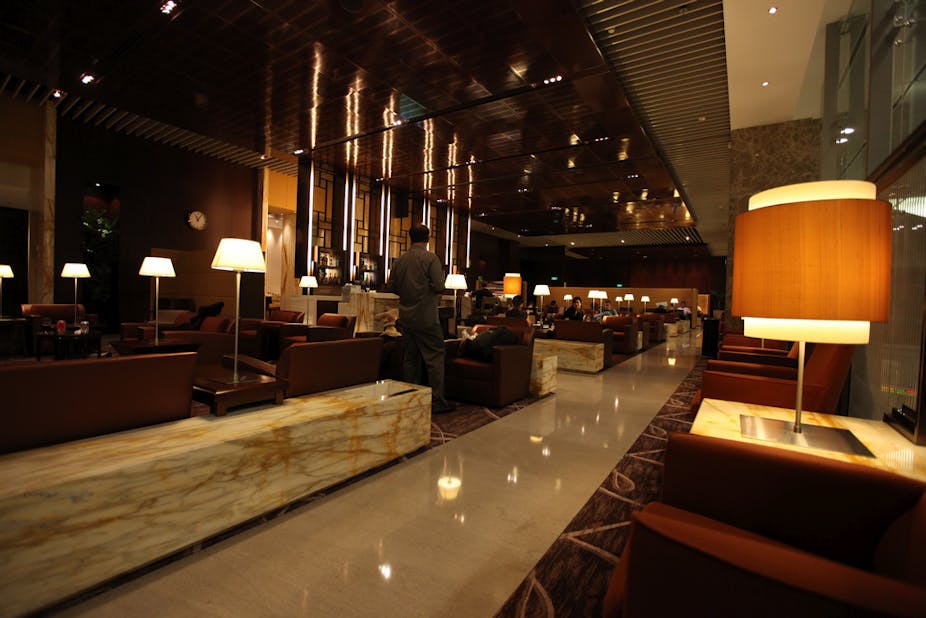Recently Qantas and Virgin have been fighting a war for “high value” corporate contracts by refurbishing their invitation-only lounges. But is this a wise strategy?
The airline industry has long been stuck in the mindset of Pareto’s Law: that 80% of your profit comes from 20% of your customers. Qantas and Virgin are no different, going head to head to refurbish their lounges in order to attract lucrative corporate accounts.
Ansett followed a similar approach during my time as a marketer at the airline: Focus on the high value customer, give them lounge access, priority baggage and a range of other privileges that will make them feel “valued”. But the evidence on consumer and business purchase patterns suggests focusing on high value corporate clients may be a little short sighted, and narrow minded.

Firstly, in most cases, high value customers not in corporate contracts (or in what is described as a repertoire market) are the least likely to be loyal to an airline.
Airline marketers may believe they offer select customers exclusive benefits, but thanks to the natural competition that occurs in a marketplace; the offering across competitors often ends up being indistinguishable to the customer.
In Australia, it is very likely such “high value” customers at an aggregate level switch across the competing airlines such as Qantas, Virgin, Jetstar and Tiger in line with their market share. Don’t believe me? Just ask anyone who flies regularly how many frequent flyer cards they hold.
Statistically, a customer who buys from a category most frequently is most likely to share their purchases across a small group of brands (because there are more purchase occasions during which switching may happen). This is known as the Duplication of Purchase (DoP) Law.
In airlines, because there is a natural limitation to the distribution it may even be more likely that customers spread their purchases across more brands, but this is to be empirically confirmed.
In the case of corporate contracts, the travellers are simply tied into contracts for a period of time, and at the end of the contract it is very likely the switching occurs just as would be predicted by the DoP Law. That is, the switching of corporate contracts would be most likely to be distributed in line with each airline’s market share in the corporate market when they are being renewed.
While it is a good idea to give customers a decent level of service, the second issue is that many companies do this for “high value” customers, but believe there is no point doing it for low yield customers. Yet, as demonstrated by Professor Byron Sharp in his book How Brands Grow, it is precisely such infrequent users of the brand that offer the best likelihood of brand growth.
We know that consumers spread their purchases across a repertoire of brands. The question is, do airline marketers know what their “typical” customer (as in on the 50th percentile on a distribution of purchase frequency) looks like?

It is likely that a “typical” customer flies with them once a year, not once per week. Such customers have recently seen access to lounges made more difficult by both Qantas and Virgin. Qantas has over recent years significantly increased the cost of Qantas Club membership to their less regular flyers and Virgin has recently ceased its partnership with Priority Pass.
Both of these factors have probably reduced the attractiveness of both airlines to their “typical” customers, and also to high value customers of their competitors who occasionally travel with them as part of the customer’s repertoire of airlines.
A final issue is specific to airlines. Not impressing lower yield customers may seem irrelevant. But particularly in the airline industry they are crucial. Such customers often buy lower yield fares and have more flexibility in their travelling times. It is precisely this that allows an airline to have a more flexible timetable that enables the “high value” customers to fly at times that are convenient to them.
Qantas and Virgin need to take a look at what they are doing. Spending millions of dollars on lounges that will benefit a very small proportion of their customer base while reducing the attractiveness of their airline to “typical” customers may not be the best way forward. But constructing flash lounges that most Australians will never see does get plenty of PR.
To Alan Joyce and John Borghetti, ‘typical’ customers may seem irrelevant. Ignore them at your own risk.

